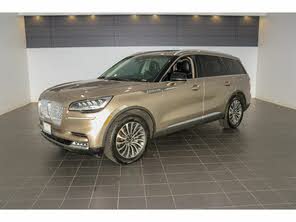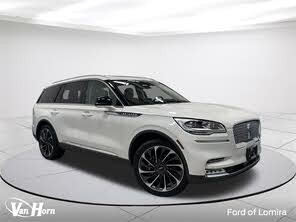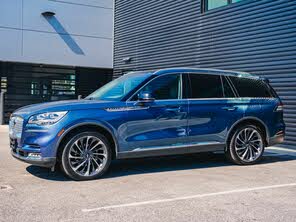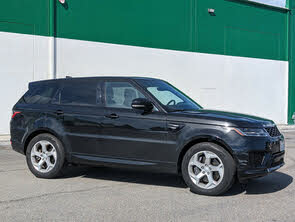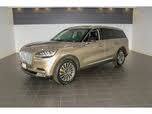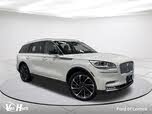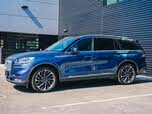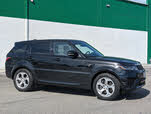2020 Lincoln Aviator vs 2020 Land Rover Range Rover Sport
CarGurus highlights
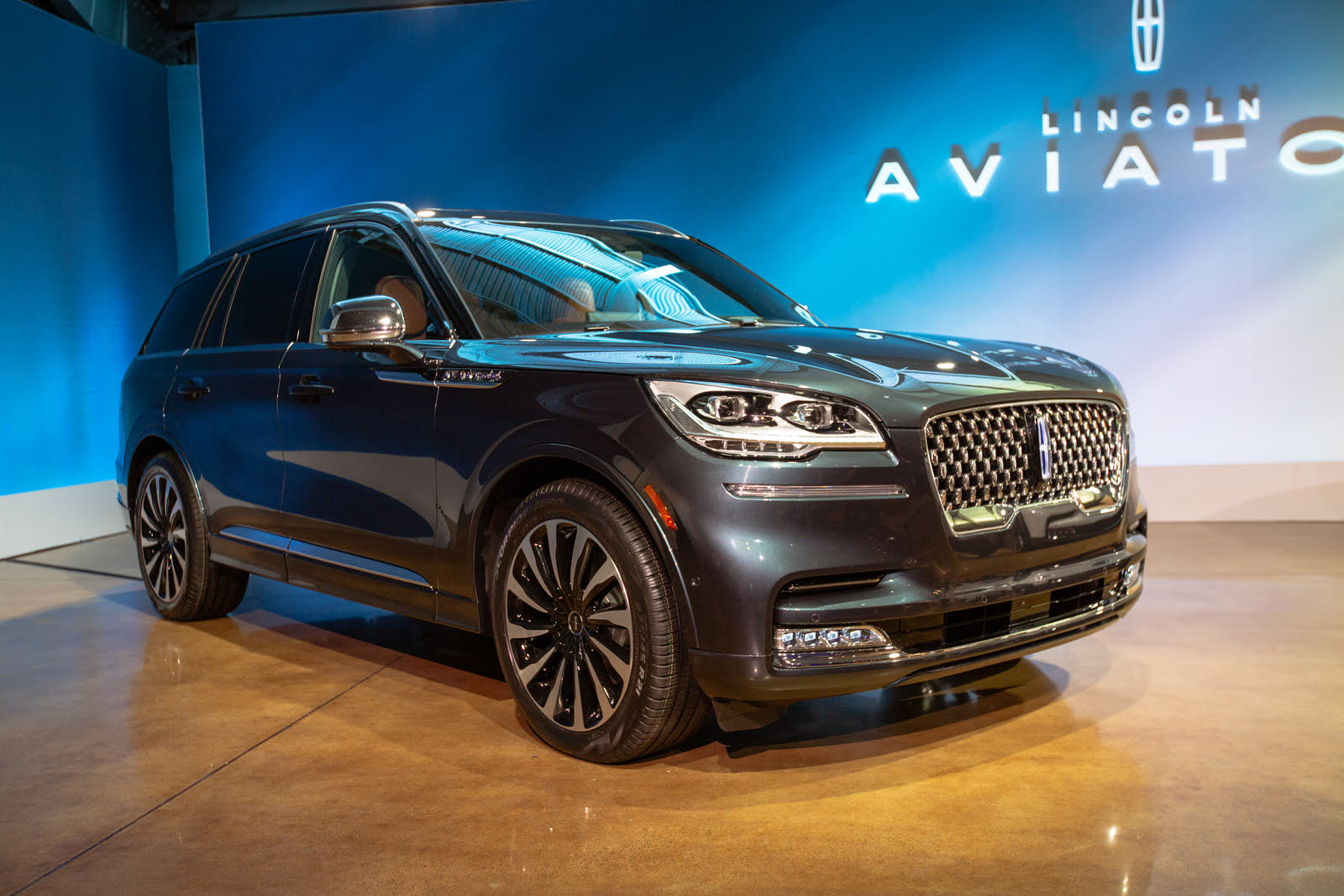
According to CarGurus experts, the overall rating for the 2020 Lincoln Aviator is 8.2 out of 10, while the 2020 Land Rover Range Rover Sport scores 6.7 out of 10. Based on these ratings, the 2020 Lincoln Aviator is the clear choice, offering a better overall package with its luxurious interior, powerful hybrid option, and user-friendly technology.
Choose the 2020 Lincoln Aviator if:
- You prioritize a luxurious and comfortable interior with high-quality materials.
- You want a powerful and efficient plug-in hybrid option.
- You appreciate user-friendly technology and infotainment systems.
Choose the 2020 Land Rover Range Rover Sport if:
- You need a vehicle with off-roading capabilities and adaptive air suspension.
- You prefer a stylish and well-equipped SUV with a strong presence.
- You are comfortable with complex technology and infotainment systems.
Overview | |
MSRP$51,100 | MSRP$68,650 |
Average price$36,420 | Average price$43,099 |
Listings570 | Listings361 |
Ratings & Reviews | |
User Reviews | User Reviews |
Expert reviews8.2 out of 10 | Expert reviews6.7 out of 10 |
Pros
| Pros
|
2020 Lincoln Aviator Reviews SummaryThe heyday for Lincoln was more than a half-century ago. Those postwar years of prosperity and optimism were the perfect time for cars like the Continental and others. They delivered comfort and luxury, wrapped in midcentury modern styling. Even as recently as the 1990s, Lincoln was still a popular brand, riding the SUV craze with its Navigator. But after the turn of the century, Lincoln lost its ability to create new designs and looked inward and backward. Sure, retro-themed cars like the redesigned Mustang, PT Cruiser, and Chevy HHR had turned some heads, but none of those came from luxury brands. The BMWs and Mercedes of the world were all looking forward and pushing the envelope for contemporary automotive design. Meanwhile, Lincoln offered the MKX, which was based on the Ford Edge and featured ’66 Continental styling. Neat in a vacuum, but off-base compared to the modern luxury market. This experimental phase with various retro looks coincided with the move to the MK-# alphabet-soup naming convention and big improvements in the Ford lineup, where top-end trims of the Fusion overlapped with an entry-level trim of the MKZ. The combination left Lincoln a confusing, anonymous afterthought in the modern luxury game. But Lincoln is finally ready to change all that. It has a new cohesive design language, its focus is once again on luxury, and the three-letter naming convention that never meant anything to anyone other than Lincoln marketers is gone. The brand led with the 2017 Continental and 2018 Navigator, which are each impressive in their own right. But the company's lineup is growing and now includes the all-new 2020 Lincoln Aviator. Named after a luxury variant of the 2002-2005 Ford Explorer, this new Aviator is also based on the contemporary Explorer platform, but it's a luxury vehicle in its own right. Much of the success of the Lincoln brand may hinge on this midsize, 3-row luxury SUV, so you need to consider its competition, such as the Audi Q7, Infiniti QX60, and all-new Cadillac XT6. Read on to learn if Lincoln’s take on luxury will stand out in a crowded competitive field. | |
2020 Land Rover Range Rover Sport Reviews SummaryWhen you think of a plug-in hybrid electric vehicle (PHEV), the image of a dorky little hatchback car probably pops into your mind. The new 2020 Land Rover Range Rover Sport PHEV, however, is an entirely different kind of electrified vehicle. Land Rover says it retains all of its traditional land-roving capabilities while delivering greater efficiency. Based on our week-long test in this SUV’s natural habitat (the swanky suburbs of a big city), it does get remarkably good fuel economy. | |
Popular Features & Specs | |
Engine3.0L 400 hp V6 | Engine3.0L 355 hp I6 |
Drive TrainRWD | Drive TrainAWD |
Seating Capacity7 | Seating Capacity7 |
Horsepower | Horsepower355 hp @ 5500 rpm |
EV Battery Capacity | EV Battery Capacity0.2 kWh |
MPG City18 | MPG City19 |
MPG Highway26 | MPG Highway24 |
Engine | |
Engine Name3.0L 400 hp V6 | Engine Name3.0L 355 hp I6 |
Torque | Torque365 lb-ft @ 2000 rpm |
Horsepower | Horsepower355 hp @ 5500 rpm |
DrivetrainRWD | DrivetrainAWD |
Fuel Economy | |
EV Battery Capacity | EV Battery Capacity0.2 kWh |
MPG City18 | MPG City19 |
MPG Highway26 | MPG Highway24 |
Interior | |
Leather Seats | Leather SeatsStandard |
Seating Capacity7 | Seating Capacity7 |
Key Features | |
Navigation System | Navigation SystemStandard |
Safety | |
Front Crash Overall5 | Front Crash Overall |
Side Crash Overall5 | Side Crash Overall |
Dimensions & Capacity | |
Cargo Space18.3 cu ft | Cargo Space27.5 cu ft |
Curb Weight4764 lbs | Curb Weight4870 lbs |
Height69.8 in | Height71.0 in |
Length199.3 in | Length192.1 in |
Width89.9 in | Width87.4 in |
Wheelbase119.1 in | Wheelbase115.1 in |
Maximum Payload | Maximum Payload1850 lbs |
Number of doors4 | Number of doors4 |
Maximum Towing Capacity | Maximum Towing Capacity7716 lbs |
CarGurus highlights

According to CarGurus experts, the overall rating for the 2020 Lincoln Aviator is 8.2 out of 10, while the 2020 Land Rover Range Rover Sport scores 6.7 out of 10. Based on these ratings, the 2020 Lincoln Aviator is the clear choice, offering a better overall package with its luxurious interior, powerful hybrid option, and user-friendly technology.
Choose the 2020 Lincoln Aviator if:
Shop Now- You prioritize a luxurious and comfortable interior with high-quality materials.
- You want a powerful and efficient plug-in hybrid option.
- You appreciate user-friendly technology and infotainment systems.
Choose the 2020 Land Rover Range Rover Sport if:
Shop Now- You need a vehicle with off-roading capabilities and adaptive air suspension.
- You prefer a stylish and well-equipped SUV with a strong presence.
- You are comfortable with complex technology and infotainment systems.
Overview | ||
MSRP | $51,100 | $68,650 |
Average price | $36,420 | $43,099 |
Listings | ||
Ratings & Reviews | ||
User reviews | 4.5 | 4.7 |
Expert reviews | 8.2 out of 10Read full review | 6.7 out of 10Read full review |
Pros & cons | Pros
| Pros
|
Summary | The heyday for Lincoln was more than a half-century ago. Those postwar years of prosperity and optimism were the perfect time for cars like the Continental and others. They delivered comfort and luxury, wrapped in midcentury modern styling. Even as recently as the 1990s, Lincoln was still a popular brand, riding the SUV craze with its Navigator. But after the turn of the century, Lincoln lost its ability to create new designs and looked inward and backward. Sure, retro-themed cars like the redesigned Mustang, PT Cruiser, and Chevy HHR had turned some heads, but none of those came from luxury brands. The BMWs and Mercedes of the world were all looking forward and pushing the envelope for contemporary automotive design. Meanwhile, Lincoln offered the MKX, which was based on the Ford Edge and featured ’66 Continental styling. Neat in a vacuum, but off-base compared to the modern luxury market. This experimental phase with various retro looks coincided with the move to the MK-# alphabet-soup naming convention and big improvements in the Ford lineup, where top-end trims of the Fusion overlapped with an entry-level trim of the MKZ. The combination left Lincoln a confusing, anonymous afterthought in the modern luxury game. But Lincoln is finally ready to change all that. It has a new cohesive design language, its focus is once again on luxury, and the three-letter naming convention that never meant anything to anyone other than Lincoln marketers is gone. The brand led with the 2017 Continental and 2018 Navigator, which are each impressive in their own right. But the company's lineup is growing and now includes the all-new 2020 Lincoln Aviator. Named after a luxury variant of the 2002-2005 Ford Explorer, this new Aviator is also based on the contemporary Explorer platform, but it's a luxury vehicle in its own right. Much of the success of the Lincoln brand may hinge on this midsize, 3-row luxury SUV, so you need to consider its competition, such as the Audi Q7, Infiniti QX60, and all-new Cadillac XT6. Read on to learn if Lincoln’s take on luxury will stand out in a crowded competitive field. | When you think of a plug-in hybrid electric vehicle (PHEV), the image of a dorky little hatchback car probably pops into your mind. The new 2020 Land Rover Range Rover Sport PHEV, however, is an entirely different kind of electrified vehicle. Land Rover says it retains all of its traditional land-roving capabilities while delivering greater efficiency. Based on our week-long test in this SUV’s natural habitat (the swanky suburbs of a big city), it does get remarkably good fuel economy. |
Video | ||
Popular Features & Specs | ||
Engine | 3.0L 400 hp V6 | 3.0L 355 hp I6 |
Drive Train | RWD | AWD |
Seating Capacity | 7 | 7 |
Horsepower | 355 hp @ 5500 rpm | |
EV Battery Capacity | 0.2 kWh | |
MPG City | 18 | 19 |
MPG Highway | 26 | 24 |
Engine | ||
Engine Name | 3.0L 400 hp V6 | 3.0L 355 hp I6 |
Torque | 365 lb-ft @ 2000 rpm | |
Horsepower | 355 hp @ 5500 rpm | |
Drivetrain | RWD | AWD |
Fuel Economy | ||
EV Battery Capacity | 0.2 kWh | |
MPG City | 18 | 19 |
MPG Highway | 26 | 24 |
Interior | ||
Leather Seats | Standard | |
Seating Capacity | 7 | 7 |
Key Features | ||
Navigation System | Standard | |
Safety | ||
Front Crash Overall | 5 | |
Side Crash Overall | 5 | |
Dimensions & Capacity | ||
Cargo Space | 18.3 cu ft | 27.5 cu ft |
Curb Weight | 4764 lbs | 4870 lbs |
Height | 69.8 in | 71.0 in |
Length | 199.3 in | 192.1 in |
Width | 89.9 in | 87.4 in |
Wheelbase | 119.1 in | 115.1 in |
Maximum Payload | 1850 lbs | |
Number of doors | 4 | 4 |
Maximum Towing Capacity | 7716 lbs | |
The 2020 Lincoln Aviator, positioned between the Navigator and the compact MKC (and its replacement, the Corsair), marked a return to real vehicle names, moving away from Lincoln's old alphabet-soup naming convention. This shift was a positive sign, indicating Lincoln's effort to establish a unique identity rather than mimicking imports. The Aviator featured a unified design language across Lincoln's lineup, with handsome headlights and an upright chrome grille. Its tapering roofline and low, wide beltline gave it an elongated, almost boat-like appearance. Inside, the Aviator boasted a flowing design with soft-touch materials and selective brightwork, exuding a sense of Golden Age luxury without overdoing it. The seats were both elegant and sturdy, with shifter buttons resembling piano keys. The cabin was plush, with leather extending to areas where it wasn't necessarily needed, showcasing Lincoln's commitment to luxury. Notable touches included a massive panoramic moonroof and unique warning jingles recorded by the Detroit Symphony Orchestra, highlighting Lincoln's holistic approach to luxury.
The 2020 Land Rover Range Rover Sport PHEV, aside from a subtle “P400e” badge on the tailgate, was indistinguishable from other versions of the SUV. Land Rover integrated the charging port with the grille, maintaining the vehicle's design integrity. The Range Rover Sport PHEV started at $79,000, including HSE trim, with options pushing the price to $93,200. The test vehicle featured Firenze Red paint, a black roof, and 21-inch aluminum wheels, enhancing its presence. Inside, quality materials were evident, reflecting the vehicle's price. However, the infotainment system proved complex and occasionally frustrating, with unexpected behavior and a lack of haptic feedback. Despite these issues, the Range Rover Sport PHEV offered a luxurious and comfortable interior, with heated and ventilated front seats, a panoramic glass roof, and 4-zone automatic climate control.
The 2020 Lincoln Aviator came standard with a twin-turbocharged 3.0-liter V6 engine, producing 400 horsepower and 415 pound-feet of torque. The Grand Touring trim combined this engine with a 100-hp electric motor, resulting in a net 494 hp and 630 lb-ft of torque. Both powertrains used a 10-speed automatic transmission, with the base V6 offering rear-wheel drive (RWD) or all-wheel drive (AWD), while the plug-in hybrid (PHEV) was AWD. Both versions could accelerate from 0-60 mph in about 4 seconds. The Grand Touring's hybrid setup provided smooth, confident acceleration and improved fuel efficiency, with a combined 23 mpg and a 21-mile electric-only range. The Aviator's steering was light, and its brakes were cushioned, offering a refined driving experience. Fuel economy for the conventional Aviator with RWD was 18 mpg city, 26 highway, and 21 combined, while the AWD version achieved 17 mpg city, 24 highway, and 20 combined.
The 2020 Land Rover Range Rover Sport PHEV combined a turbocharged 2.0-liter 4-cylinder gasoline engine with a 141-hp electric motor and a 13-kWh battery, producing 398 horsepower and 472 pound-feet of torque. Land Rover claimed a 31-mile all-electric driving range, but the test vehicle struggled to achieve this. The PHEV defaulted to a gas-electric hybrid mode, with an EV mode button for pure electric driving. However, the gas engine often engaged unexpectedly, and the drivetrain sometimes seemed confused. The test vehicle averaged 41.9 mpg over a 28.4-mile EV range and 25.5 mpg over a 60-mile loop. The Range Rover Sport PHEV offered quick acceleration, adaptive air suspension, and various driving modes, providing an athletic yet comfortable driving experience. The regenerative brakes were effective but grabby, making smooth stops challenging. The PHEV retained the standard model's off-roading capability, with an 8-speed automatic transmission, permanent 4-wheel drive, and multiple traction settings.
The 2020 Lincoln Aviator, with its three rows, competed with the Audi Q7, Infiniti QX60, Mercedes-Benz GLE, Land Rover Discovery, and Cadillac XT6. The optional second-row captain's chairs were fantastic, while the power-closing third row was adequate for adults but best suited for kids on longer trips. Dropping the second and third rows provided 77 cubic feet of cargo space, comparable to the Cadillac XT6. However, the Aviator's seat and door handle controls were overly complicated, with a door-release button that could be confusing for passengers.
The 2020 Land Rover Range Rover Sport PHEV suffered from a shortage of cargo space due to the battery beneath the raised cargo floor, reducing the standard version's 27.5-cubic-foot space. The cargo area was prone to items falling out when the tailgate was opened. Despite this, the Range Rover Sport PHEV comfortably accommodated five people, with excellent front-seat comfort and a tall riding position for rear-seat passengers. The test vehicle included 4-zone automatic climate control and a panoramic glass roof, enhancing the interior experience. However, practical storage was limited, especially with the optional refrigerated center console bin.
The 2020 Lincoln Aviator featured the Sync 3 infotainment system with a 10.1-inch touchscreen in a landscape layout, providing a user-friendly interface for Apple CarPlay and Android Auto. The fully digital instrument panel and a massive head-up display offered a wealth of information in a minimalist and unobtrusive manner.
The 2020 Land Rover Range Rover Sport PHEV's InControl Touch Pro Duo infotainment system was complex and occasionally frustrating, with unexpected behavior and a lack of haptic feedback. Despite spending time setting up the system, accessing specific features or functions could be challenging. The Range Rover Sport PHEV's technology required patience and familiarity, making it less suitable for technophobes.
The 2020 Lincoln Aviator came standard with a full array of front and side-impact airbags, traction control, and a tire pressure monitoring system. The Lincoln Co-Pilot360 suite included forward-collision avoidance, lane-departure warning, adaptive cruise control, automatic high beams, blind-spot monitoring, and a head-up display.
The 2020 Land Rover Range Rover Sport PHEV included advanced driver-assistance systems (ADAS) and an optional Driver Assist Package with a new steering-assist system. However, the steering-assist and lane-keeping assist systems could be abrupt and distracting. Crash-test ratings were unavailable, but the Range Rover Sport PHEV's nearly 5,500-pound weight provided a sense of security in collisions.

By: CarGurus + AI
At CarGurus, our team of experienced automotive writers remain at the heart of our content operation, conducting hands-on car tests and writing insightful guides that are backed by years of industry experience. To complement this, we are harnessing AI to make our content offering more diverse and more helpful to shoppers than ever. To achieve this, our AI systems are based exclusively on CarGurus content, ratings and data, so that what we produce is both unique to CarGurus, and uniquely helpful to car shoppers.



